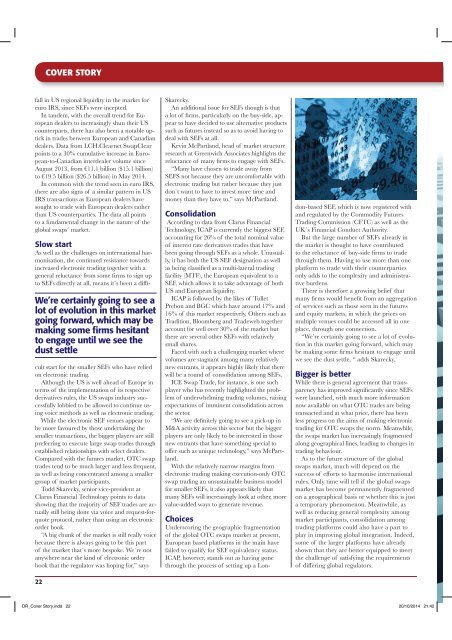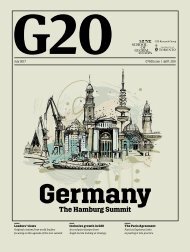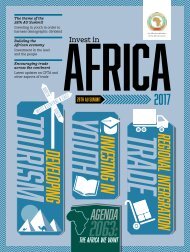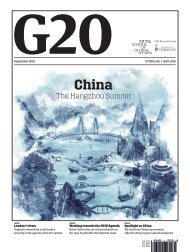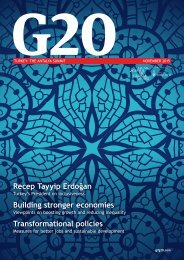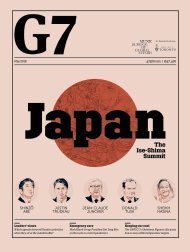SOURCE: Derivatives Special Report
SOURCE Derivatives Special Report provides expert analysis and information on the derivatives markets and provides insight into the large and complex challenges being faced by the global derivatives industry. SOURCE Derivatives Special Report strives to identify emerging risks and mitigation strategies, while covering the fascinating people who drive the industry forward. The magazine will be published in June and November 2015 and quarterly from 2016 with the launch of our website, sourcederivatives.com in September 2015. SOURCE Derivatives Special Report is the leading analytical publication on derivatives, providing a detailed study of theoretical models and how they are used in practice. SOURCE Derivatives Special Report gives you results-oriented analysis and statistical information on derivative products and techniques.
SOURCE Derivatives Special Report provides
expert analysis and information on the derivatives
markets and provides insight into the large and
complex challenges being faced by the global
derivatives industry.
SOURCE Derivatives Special Report strives to
identify emerging risks and mitigation strategies,
while covering the fascinating people who drive
the industry forward.
The magazine will be published in June and
November 2015 and quarterly from 2016 with
the launch of our website, sourcederivatives.com
in September 2015.
SOURCE Derivatives Special Report is the
leading analytical publication on derivatives,
providing a detailed study of theoretical models
and how they are used in practice.
SOURCE Derivatives Special Report gives you
results-oriented analysis and statistical information
on derivative products and techniques.
You also want an ePaper? Increase the reach of your titles
YUMPU automatically turns print PDFs into web optimized ePapers that Google loves.
COVER STORY<br />
fall in US regional liquidity in the market for<br />
euro IRS, since SEFs were incepted.<br />
In tandem, with the overall trend for European<br />
dealers to increasingly shun their US<br />
counterparts, there has also been a notable uptick<br />
in trades between European and Canadian<br />
dealers. Data from LCH.Clearnet SwapClear<br />
points to a 30% cumulative increase in European-to-Canadian<br />
interdealer volume since<br />
August 2013, from €11.1 billion ($15.1 billion)<br />
to €19.5 billion ($26.5 billion) in May 2014.<br />
In common with the trend seen in euro IRS,<br />
there are also signs of a similar pattern in US<br />
IRS transactions as European dealers have<br />
sought to trade with European dealers rather<br />
than US counterparties. The data all points<br />
to a fundamental change in the nature of the<br />
global swaps´ market.<br />
We’re certainly going to see a<br />
lot of evolution in this market<br />
going forward, which may be<br />
making some firms hesitant<br />
to engage until we see the<br />
dust settle<br />
Slow start<br />
As well as the challenges on international harmonisation,<br />
the continued resistance towards<br />
increased electronic trading together with a<br />
general reluctance from some firms to sign up<br />
to SEFs directly at all, means it´s been a difficult<br />
start for the smaller SEFs who have relied<br />
on electronic trading.<br />
Although the US is well ahead of Europe in<br />
terms of the implementation of its respective<br />
derivatives rules, the US swaps industry successfully<br />
lobbied to be allowed to continue using<br />
voice methods as well as electronic trading.<br />
While the electronic SEF venues appear to<br />
be more favoured by those undertaking the<br />
smaller transactions, the bigger players are still<br />
preferring to execute large swap trades through<br />
established relationships with select dealers.<br />
Compared with the futures market, OTC swap<br />
trades tend to be much larger and less frequent,<br />
as well as being concentrated among a smaller<br />
group of market participants.<br />
Todd Skarecky, senior vice-president at<br />
Clarus Financial Technology points to data<br />
showing that the majority of SEF trades are actually<br />
still being done via voice and request-forquote<br />
protocol, rather than using an electronic<br />
order book.<br />
“A big chunk of the market is still really voice<br />
because there is always going to be this part<br />
of the market that´s more bespoke. We´re not<br />
anywhere near the kind of electronic order<br />
book that the regulator was hoping for,” says<br />
22<br />
Skarecky.<br />
An additional issue for SEFs though is that<br />
a lot of firms, particularly on the buy-side, appear<br />
to have decided to use alternative products<br />
such as futures instead so as to avoid having to<br />
deal with SEFs at all.<br />
Kevin McPartland, head of market structure<br />
research at Greenwich Associates highlights the<br />
reluctance of many firms to engage with SEFs.<br />
“Many have chosen to trade away from<br />
SEFS not because they are uncomfortable with<br />
electronic trading but rather because they just<br />
don`t want to have to invest more time and<br />
money than they have to,” says McPartland.<br />
Consolidation<br />
According to data from Clarus Financial<br />
Technology, ICAP is currently the biggest SEF,<br />
accounting for 26% of the total nominal value<br />
of interest rate derivatives trades that have<br />
been going through SEFs as a whole. Unusually,<br />
it has both the US SEF designation as well<br />
as being classified as a multi-lateral trading<br />
facility (MTF), the European equivalent to a<br />
SEF, which allows it to take advantage of both<br />
US and European liquidity.<br />
ICAP is followed by the likes of Tullet<br />
Prebon and BGC which have around 17% and<br />
16% of this market respectively. Others such as<br />
Tradition, Bloomberg and Tradeweb together<br />
account for well over 30% of the market but<br />
there are several other SEFs with relatively<br />
small shares.<br />
Faced with such a challenging market where<br />
volumes are stagnant among many relatively<br />
new entrants, it appears highly likely that there<br />
will be a round of consolidation among SEFs.<br />
ICE Swap Trade, for instance, is one such<br />
player who has recently highlighted the problem<br />
of underwhelming trading volumes, raising<br />
expectations of imminent consolidation across<br />
the sector.<br />
We are definitely going to see a pick-up in<br />
M&A activity across this sector but the bigger<br />
players are only likely to be interested in those<br />
new entrants that have something special to<br />
offer such as unique technology, says McPartland.<br />
With the relatively narrow margins from<br />
electronic trading making execution-only OTC<br />
swap trading an unsustainable business model<br />
for smaller SEFs, it also appears likely that<br />
many SEFs will increasingly look at other, more<br />
value-added ways to generate revenue.<br />
Choices<br />
Underscoring the geographic fragmentation<br />
of the global OTC swaps market at present,<br />
European based platforms in the main have<br />
failed to qualify for SEF equivalency status.<br />
ICAP, however, stands out as having gone<br />
through the process of setting up a London-based<br />
SEF, which is now registered with<br />
and regulated by the Commodity Futures<br />
Trading Commission (CFTC) as well as the<br />
UK´s Financial Conduct Authority.<br />
But the large number of SEFs already in<br />
the market is thought to have contributed<br />
to the reluctance of buy-side firms to trade<br />
through them. Having to use more than one<br />
platform to trade with their counterparties<br />
only adds to the complexity and administrative<br />
burdens.<br />
There is therefore a growing belief that<br />
many firms would benefit from an aggregation<br />
of services such as those seen in the futures<br />
and equity markets, in which the prices on<br />
multiple venues could be accessed all in one<br />
place, through one connection.<br />
“We’re certainly going to see a lot of evolution<br />
in this market going forward, which may<br />
be making some firms hesitant to engage until<br />
we see the dust settle, “ adds Skarecky.<br />
Bigger is better<br />
While there is general agreement that transparency<br />
has improved significantly since SEFs<br />
were launched, with much more information<br />
now available on what OTC trades are being<br />
transacted and at what price, there has been<br />
less progress on the aims of making electronic<br />
trading for OTC swaps the norm. Meanwhile,<br />
the swaps market has increasingly fragmented<br />
along geographical lines, leading to changes in<br />
trading behaviour.<br />
As to the future structure of the global<br />
swaps market, much will depend on the<br />
success of efforts to harmonise international<br />
rules. Only time will tell if the global swaps<br />
market has become permanently fragmented<br />
on a geographical basis or whether this is just<br />
a temporary phenomenon. Meanwhile, as<br />
well as reducing general complexity among<br />
market participants, consolidation among<br />
trading platforms could also have a part to<br />
play in improving global integration. Indeed,<br />
some of the larger platforms have already<br />
shown that they are better equipped to meet<br />
the challenge of satisfying the requirements<br />
of differing global regulators.<br />
DR_Cover Story.indd 22 20/10/2014 21:42


